Inspired is the word we would use to describe Tinykin. It’s a game that definitely will make you smile at some point, not because of its originality or innovative mechanics, not even because of the cute characters or the awesome incidental instrumentation in its music.
It will make you smile because of the familiarity and right at home feel that welcomes you at every corner.
Tinykin is a game that wants to make sure at no point you feel frustrated or lost, but it won’t hold your hand and will let you do whatever you want.
With few words you will know exactly where you need to go and what to do; Tinykin first and foremost aims to entertain and tries hard so you can have a good time.
Despite the initial impression of its introduction, Tinykin presents us with a simple quest. We take the role of Milodane, a scientist studying the origins of the universe. The exploration has taken us to a strange planet that might hold the key to such knowledge, but now we are stranded with no way back. It’s up to us to build a ship that can take us back home and continue the research.
To help us in this quest we rapidly make a friend from this world, Ridmi, who is also interested in this kind of study. And to our surprise he has already located and has a clear blueprint of what we need to complete our escape.
At this moment many will know exactly what’s coming, and it only gets better from here.
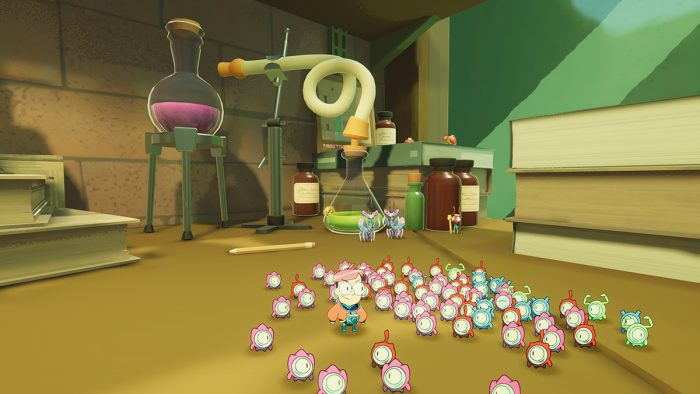
On the planet we only have a couple of abilities: we can jump, and thanks to our space suit we can create an air bubble that helps us glide for a limited amount of time. To explore we rely only on this to find a way in what turns out to be a house for giants. Everything is humongous and we are barely the size of an ant.
With Ridmi as our guide, we rapidly find that there are many creatures living here, and among them we meet the Tinykin. These little beings immediately take a liking to Milodane, and as they follow, we find out that there is more to these cute little minions after us.
If we point them at things, they will be able to lift, push, move or blow away certain items or obstacles, helping us advance in our quest to obtain the required items or lend aid to some inhabitants in each area. After going through the first door with a bit of help from Ridmi, we find ourselves in an enormous living room. This is where we find the first Tinykin type, red. Once we throw this specific type it explodes on contact. It’s our introduction to resource management, too, because we can collect some of the items that the explosions can interact with.
This and an extra gift from Ridmi, a soap bar that can be used like a hover-board, quickly add to our abilities to explore the immense room in front of us and find the parts we need.
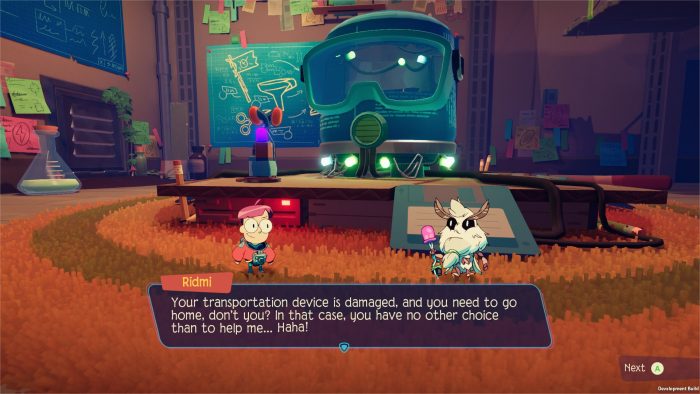
As we traverse and get to know more of the world we are in now, the bugs living in it will tell us little tidbits of information about their ways of life, needs and especially about a deity they worship as their savior and guide, opening up to one of the key elements of the plot.
Our second Tinykin creature is a blue one which, instead of exploding, has a knack for strength, helping us to carry, push, pull or lift things. Some things are easily done by a single one of them, while other obstacles require us to bring a specific number so they could team up.
Along our exploration of the environments we find another valuable currency, specks of pollen. Collecting enough of it will grant us a must have upgrade for our suit, prolonging the time we can use the glide bubble and allowing us to uncover even more secrets in the rooms. There are a number of tasks and resources for us to complete and collect in each of them, but sometimes we will need to come back later to be able to do so.
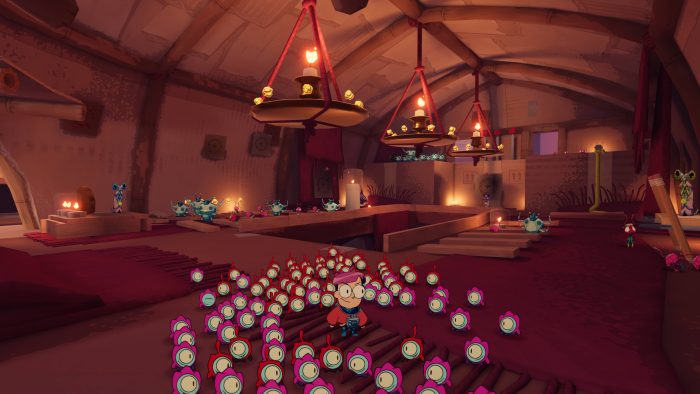
Once we obtain the key part we need in each room a new door will open, allowing us to access the next and leaving behind all of our followers at that room. This is because as Ridmi explains, they are a shy bunch that dare not go further, but will wait for us where we left them when we come back. This effectively makes each room a new challenge where we have to find our way using newly gained resources and skills we can secure in it.
Tinykin has a lot going for it, including some things that very few games do lately, such as how the music changes mood and adapts incidentally to each point in the world, making it feel like another character in your adventure. Sometimes it includes the singing of the surrounding creatures, sometimes giving a grimmer undertone or a more cheerful or sophisticated vibe.
Then there are the controls; they are quick and intuitive, the reactions are fast and we don’t find ourselves waiting for one action to finish before we can switch to another. We can truly zip through the environments as fast as we need to without much down time.
It’s a game that embraces any approach we decide to take with it and won’t punish us for even getting ahead of time on things. If we find a key item we will need for a quest before you know it, that is fine, it will count towards its completion at the right time. Should we have trouble finding them it will give us a generous clue, without it telling us specifically to go somewhere. The same happens with some upgrades, as they will definitely make our life easier if we have what it requires, but if we are creative we can mix and match our skills to make up for what we are missing sometimes.
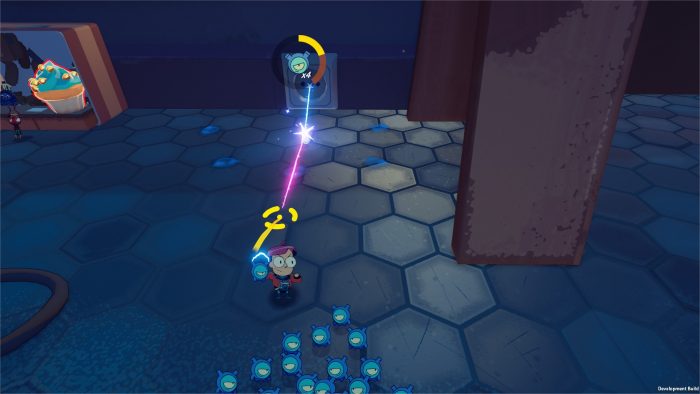
Not completing every task will not limit us from advancing. We can come back and finish them at any time. They can be taken on as hard or as easy as we want them to be, opening the door to all kinds of players and skill levels. If we are a seasoned player we will soar and enjoy the feel of the game not pacing us, and if we are a beginner, it will let us grow and offer us just the right amount of challenge without frustration.
Worth mentioning is that Tinykin is a game without big battles or bosses to beat, and it’s impressive how we never feel the need for them or miss their lack of their inclusion. It’s all about the feel of exploration, making friends and making our way home.
The art and visuals of Tinykin are also a key point. They create a very believable feel of scale and depth, are cheerful and uncomplicated, but manage to keep some kind of mystery at every corner. The characters are well-designed and the Tinykin very charming, including some cartoon quality interactions for when we meet them or as we reach key moments in our journey.
Tinykin is a package that does the most with each of its qualities, creating an adventure that is memorable from start to end. It’s a game that won’t overstay its welcome but will leave a few reasons for most to come back to it, should we want more after the credits. It has a feeling of polish that not many Independent developers achieve, and even if its inspirations are obvious, it manages to mix a flavor of its own during the 8 or so hours it took us to complete. It’s easily one of the best indies we have played this year.
—-
We played Tinykin thanks to a PC review code provided by its developer.
—-
Games to try if you like Tinykin:
Pikmin series (A new one has just been announced for Nintendo Switch).
Kirby Mass Attack.
Overlord series.
—-
Some tips:
When you start a new area you usually start at the ground level. It is tempting to go up and explore upward right away, but if you first explore the floor it will make your progress on each level easier.
Use the pollen specks as your guide, as they will usually help you find places you have yet to explore and probable paths you can take, including many hints for secrets.
Remember that you can also use your Soapbar to grind on any corner like a skateboard, and it will help you travel some thin surfaces easier.
If you time your bubble right, you can cover longer distances than if you just keep it on all the time and even save you from otherwise deadly falls.

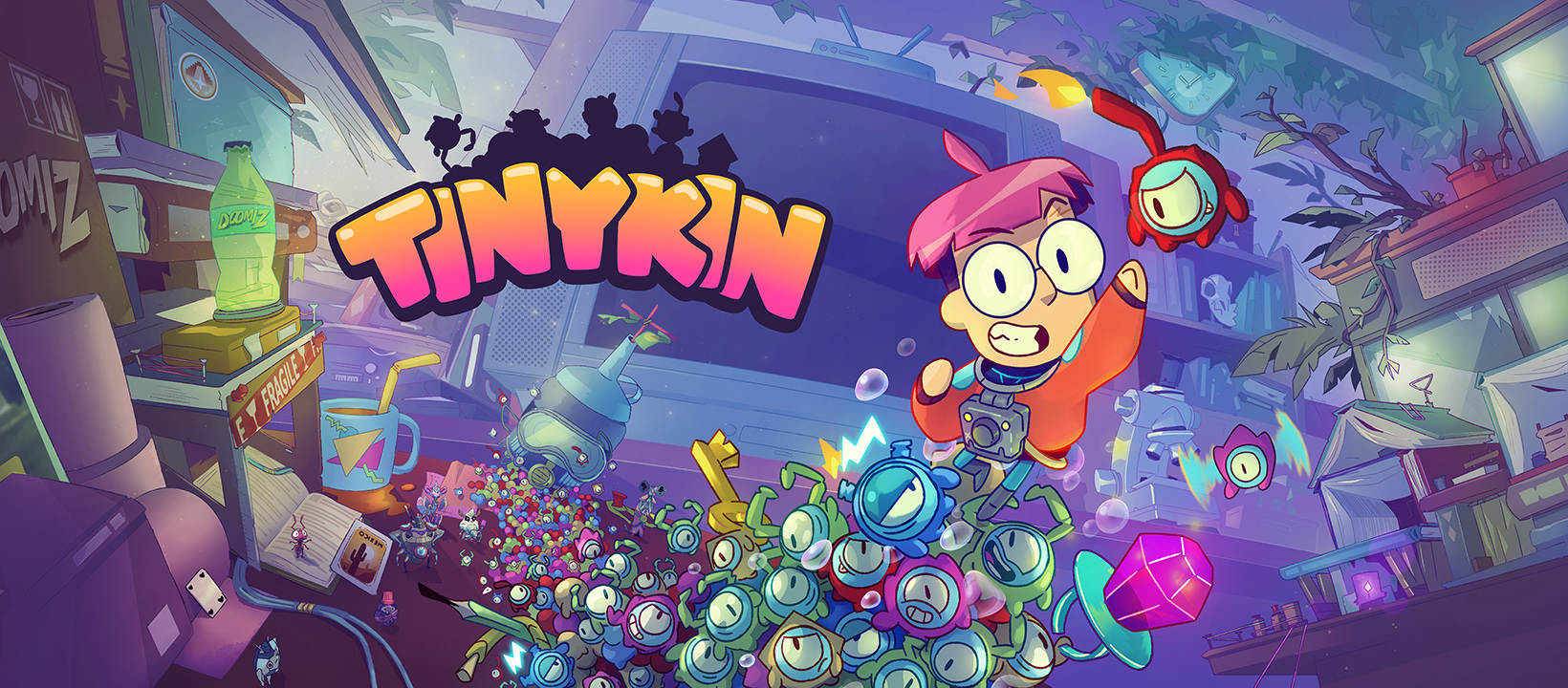
No Comments